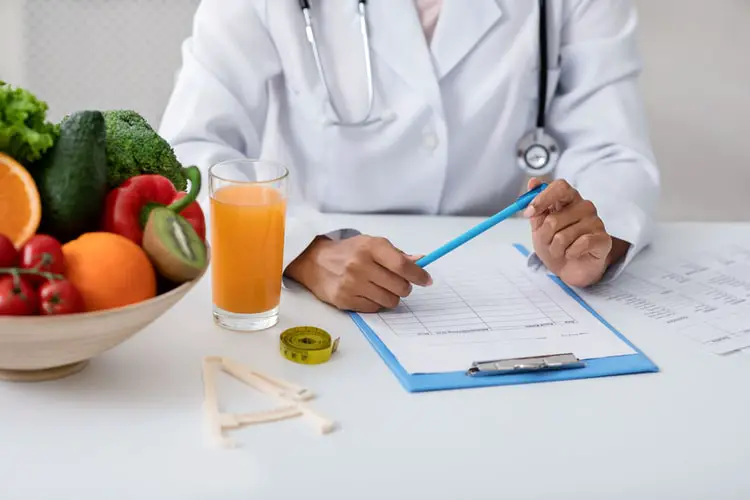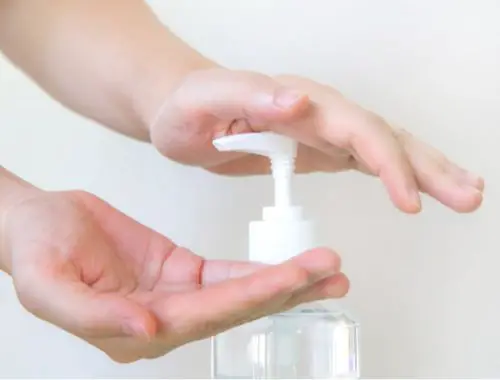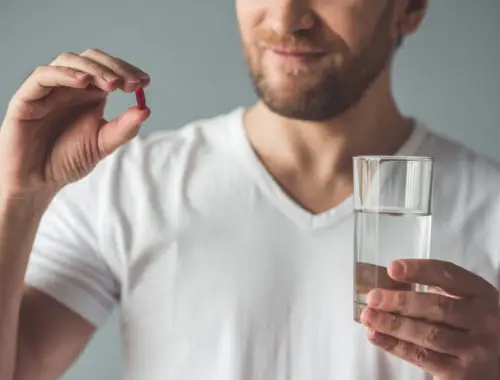You’ll find juicing for weight loss and detox juice recipes all over the Internet, but there’s a right way and a wrong way to juice. So when researching how to juice, make sure you follow expert advice.
Yes, you can create healthy juices right at home. Will they detox your system or make you lose weight? Probably not.
Now, that doesn’t mean you can’t get benefits from juicing. Let’s walk through how to juice and get started with 3 great recipes!
What is Juicing?
Juicing is the process of extracting juice and water from fruits and vegetables — even some nuts, seeds, roots, herbs and oats can be juiced too!
Juicers press out the liquid and discard the solids, leaving you with a nutritious, hydrating drink.
Blending vs. Juicing
Blending in a Nutribullet or blender is not the same as juicing. In fact, the texture, ingredients and nutrition can be very different.
Blending pros and cons:
- Less mess than juicing
- More fiber and nutrition
- More ingredient choices
- Can be higher in calories
- May have too many fruit servings
Juicing pros and cons:
- Can be lower in calories
- Filled with hydrating fluid
- Messy and lots of clean up
- More food waste (pulp and skins)
- Need extra produce for a single serving
Is juicing healthy?
The healthiest way to juice is to use it as supplemental nutrition. Along with a healthy diet, juicing can help add to your daily nutrient profile.
A big downside to juicing is that it lacks fiber and other nutrients you’d get from eating whole fruits and vegetables.
What you don’t want to do is make juicing your sole form of nutrition. You’ll be undernourished, exceptionally hungry… and likely miserable. The bottom line: Juice cleanses are brutal and ineffective.
Juicing for weight loss
While your friend may swear by a juice cleanse, juicing diets are fads. You may shed pounds temporarily, if at all. Typically, juice diets last a few weeks, and you regain the weight when you return to solids.
How to juice and lose real weight:
- Replace your dessert with a low-calorie juice drink
- Replace commercial juices with your at-home juices
- Avoid adding sugar, honey or syrup to your blends
- Drink a large glass of low-calorie juice before eating to fill your stomach
- Have homemade juice when you’re hungry between meals
Juicing for detox
As long as you’re healthy overall, you detox naturally. Your kidneys, liver, skin, gut and lungs are nature-made detoxers!
How to support your body’s natural detoxification:
- Limit alcohol
- Get active and sweat
- Stay hydrated
- Don’t smoke
- Eat a healthy diet
How to Juice
So here’s the question you’d like answered: how to juice? Juicing is easy if you have the right tools and ingredients. Let’s go step-by-step on how to juice!
Step 1: Get a great juicer.
You can juice manually, but that takes so much time and effort. If you want to get started juicing, invest in an electric juice extractor.
There are 2 common types of juicers on the market. A centrifugal juicer “spins out” the juice from a fruit or vegetable. A masticating juicer (AKA “cold press juicer”) grinds the produce and strains out the liquid.
Step 2: Know what you can and can’t put in a juicer.
Read the manual on your electric juicer so you don’t break it! Here are a few general guidelines for juicing:
What can you juice?
For the most part, if it’s a juicy fruit or vegetable, juice it! But, there are some not-so-obvious juicing ingredients too. This is not an exhaustive list.
| Best Fruits for Juicing | Best Vegetables for Juicing | Other Foods You Can Juice |
|---|---|---|
| Oranges | Beets | Almonds (soaked) |
| Pineapple | Carrots | Oats (soaked) |
| Lemon and lime | Cabbage | Fresh herbs |
| Papaya | Dark green leafies | Ginger root |
| Small berries | Cucumber | Turmeric root |
| Cherries (pitted) | Tomato | Sweet potato |
| Apples | Celery | Pistachios (soaked) |
| Strawberries | Wheatgrass | Fennel |
What can’t you juice?
Some things don’t juice well (and can break your juicer). If a food doesn’t have high water content, it likely won’t work. This is not an exhaustive list.
| Foods that Can’t Be Juiced |
|---|
| Banana |
| Avocado |
| Coconut oil |
| Coconut flesh |
| Rhubarb |
| Eggplant |
| Squash |
| Figs |
| Dried fruit |
| Onion |
| Ice |
Step 3: Clean everything.
Clean your juicer, your produce and your hands. Unlike juice you get at a store, your homemade juice won’t be pasteurized. So, if there’s bacteria on your produce or juicer, it’ll end up in your glass. 2 3
Into the juicer:
- 2 cups Swiss chard
- 1.5 cups sweet potato, peeled and cubed
- 1.5 cups papaya chunks
Blend and/or garnish after juicing:
- 2 tsp cinnamon
- ½-¾ cup unsweetened almond milk
#2 No-Grass Green Juice
No need to drink a green juice that tastes like grass! Pineapple, lemon and green apples make this juice super fresh! Dark green leafies like kale are filled with vitamin K, an essential nutrient for healthy blood clotting. 4
Into the juicer:
- 2 cups kale
- 2 green apples
- 1 cup cucumber
- 1 celery stalk
- 1 cup pineapple chunks
- 2 Tbsp lemon juice
Blend and/or garnish after juicing:
- 2 fresh mint leaves
- 1 cup coconut water, chilled
#3 Brain Boost Juice
With a light kick of caffeine and brain-boosting blueberries, you’ll get your brain stimulated and ready to take on tough tasks. 5 The chia seeds give you heart healthy omega-3s and gel up in the drink, making it really satisfying. 6
Into the juicer:
- 2 cups spinach
- 2 cups blueberries
- 1 Tbsp lime juice
Blend and/or garnish after juicing:
- 2 Tbsp chia seeds
- 1 cup coconut water, chilled
- 1 cup green tea, chilled
Hope this how to juice guide is helpful. If you want more juicing recipes, check out our top 10 healthy juicing recipes!
Article Sources
Healing Daily uses only high-quality sources, including peer-reviewed studies, to support the facts within our articles. Read our editorial process to learn more about how we fact-check and keep our content accurate, reliable, and trustworthy.
- Newgent J. The juicing trend: About raw juice. Eatright.org. Published October 15, 2018. Accessed January 25, 2021.[/efn_note}
Step 4: Prep your produce.
Along with a clean workspace and produce, you may have to peel and/or chop some of the produce ahead of time.
In general, produce that has a skin like oranges, ginger and beets should be peeled before juicing. Watermelon and pineapple may ease the burden on your juicer if they’re diced.
Step 5: Juice it!
You can pretty much put in your ingredients and let the juicer do the work. Remember to avoid adding ice — that can be added to your cup after juicing.
Step 6: Clean and save what you can.
After enjoying your drink, make sure you clean all parts of the juicer ASAP. Juicers will leave behind fibrous pulp and skin, which can be really nutritious!
Try to repurpose the scraps when appropriate (and when food safety is observed). Here are some great ideas for juicer scraps!
- Compost
- Dye
- Soaps and scrubs
- Animal feed
- Pesto
- Carrot cake
- Fruit leather
- Popsicles
- Cream cheese spread
- Smoothies
- Soup thickener
- Tea “leaves”
- Sauce
- Bread and other baked goods
- Fruit preserves
Health Considerations Before Juicing
There are several reasons why someone should not juice. Total juice cleanses — where you’re only drinking juice — should be avoided. But, there are other interactions and behavioral issues that contraindicate juicing.
If you have any of these below, talk to your doctor and Registered Dietitian before starting a juice routine:
- Risk or history of eating disorders
- Warfarin or coumadin medication
- Kidney conditions
- Compromised immune system
- Limited or restricted diet
- Malnutrition
- Gut disorders
3 Best Juicing Recipes for Beginners
#1 Papaya Punch
This sweet, filling drink is a great way to start juicing! It’s filled with vitamin A and C — 2 nutrients packed with antioxidant power and essential for cellular health and immunity. 1Huang Z, Liu Y, Qi G, Brand D, Zheng SG. Role of vitamin A in the immune system. J Clin Med. 2018;7(9):258. Published 2018 Sep 6. doi:10.3390/jcm7090258
- Maggini S, Pierre A, Calder PC. Immune function and micronutrient requirements change over the life course. Nutrients. 2018;10(10):1531. Published 2018 Oct 17. doi:10.3390/nu10101531
- Office of Dietary Supplements. Vitamin K. NIH website. Published Jun 3, 2020. Accessed January 25, 2021.
- Miller MG, Hamilton DA, Joseph JA, Shukitt-Hale B. Dietary blueberry improves cognition among older adults in a randomized, double-blind, placebo-controlled trial. Eur J Nutr. 2018;57(3):1169-1180. doi:10.1007/s00394-017-1400-8
- Klemm S. What are chia seeds. Eatright.org. Published January 25, 2021. Accessed January 25, 2021.









